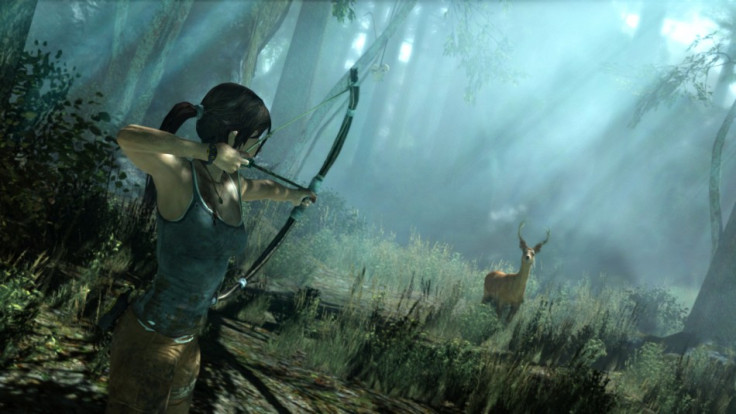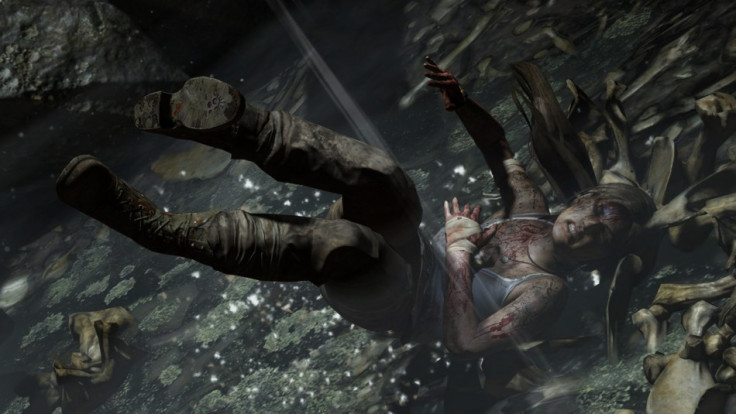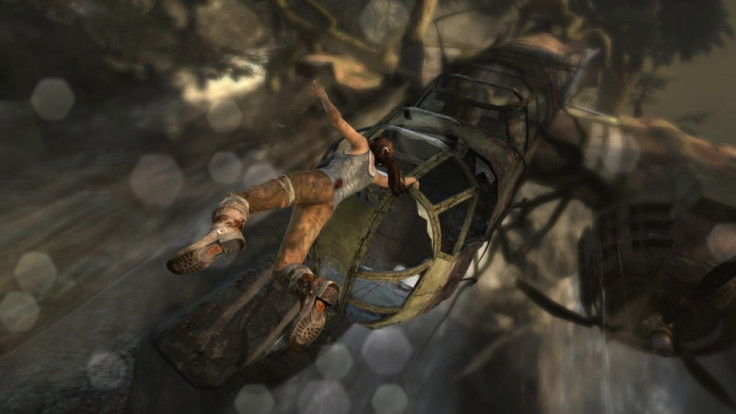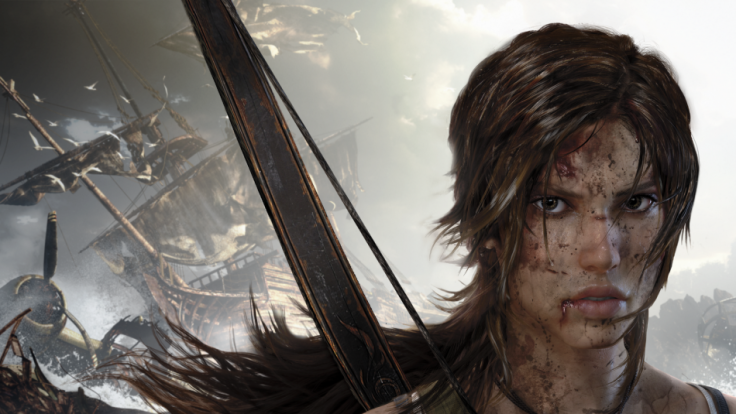Tomb Raider Review: The Debate is Coming

Key Features
- Developer - Crystal Dynamics
- Publisher - Square Enix
- Platforms - Xbox 360 (tested). PlayStation 3, Microsoft Windows
- Release date - Out now
- Price - £39.99
Tomb Raider
Over the next few months, there will be no doubt reams of healthy debate over Lara Croft and the "new" depiction of female characters in videogames. She's capable, she's feminine; she battles an all-male cult that considers itself enslaved to a Queen. But although there's a feminist dialogue happening in Crystal Dynamics' Tomb Raider reboot, it's not, I don't think, the most interesting conversation the game is having.
On the one hand, I'm reticent to ask people to try and forget that Lara is a woman. Through her backstory, her relationships with other characters and her plausible physical shape, Tomb Raider wants you to recognise Lara's femaleness. She's not a frail Princess Peach, nor is she a penis-envious, Aeon Flux-style ass kicker. She's perfectly normal; she's a woman. But on the other hand, I think it might help to look, somewhat, past Lara's gender.
When I interviewed Tomb Raider's writer, Rhianna Pratchett, she seemed far more interested in humanising rather than gendering game characters. Like a lot of people in the post Call of Duty age, she seems frustrated with the omnipresence of emotionally impervious, undercooked superheroes - it's people she wants to play as, not, necessarily, women.
So, to some extent, Croft's womanhood is an irrelevance - what's more interesting is her humanity. Like when Bond almost dies in the Casino Royale reboot, the first time you see Lara Croft bleed, or cry, or shiver in the cold, it's a wonderful, ugly, moment. Badly wounded and hunched over a campfire, she pleads with her friends over the radio to please, come and find her. You can't help but feel impressed that games are suddenly capable of this kind of emotional nuance, but at the same time, you're watching this hurt young person pleading for help, and it's miserable.

And the game never lets that up. Time after time Lara is stabbed, shot, slammed against the ground - there's one particularly wince-inducing moment when she's grabbed by the neck and repeatedly punched in the face by a thuggish bad guy. Tomb Raider makes a point of really damaging Lara, not just emotionally, when her friends are in peril, but physically, too. And as she sobs in pain and the blood trickles down her forehead there's no mistaking that this is a person. She's not a bundle of pixels, she's not just eye-candy - Rhianna Pratchett's Lara Croft is a human being.
Moralising
Well, at least to begin with.
Although Tomb Raider makes a point of brutalising Lara throughout (there's a truly painful scene late in the game where she jumps into a pool of old, gooey blood) her transition from adventurous young woman to trained, able killer happens way too quickly. Her Injun Joe moment comes very near the game's beginning, when she's forced to kill someone for the first time and gets her hands on a gun.
From thereon, Lara's a competent murderer and her arc, for the most part is complete. That leaves the character with not a lot of places to go and that interesting reinvention of her is more or less forgotten.
That said, this is very much a genre game; there's an applaudable degree of moralising on Pratchett's part, but neither she nor the team at Dynamics forgets that what they are creating is a third-person shooter. And it's not like the violence done by Lara is shown to be without consequence. On a couple of occasions the camera swings nauseatingly close to head wounds and blood spatters, and there's a melancholy, I think, around Lara's gradual transformation.
In the early parts of the game when I was attacked by baddies, Croft would call to them: "Look, you don't have to do this." A few dozen bodies later, I found a guy slumped against a wall, coughing his last: "Please, just kill me," he said. "Go to hell," spat Lara, after shooting him in the head.

So, there's definitely some moralising when it comes to Tomb Raider's violence - as gameplay director Daniel Bisson told me, the villains in the game get physically further and further away as Lara becomes more comfortable with killing them.
But it's balanced well with the game's genre conceits. Action and thrills still take prevalence here, and Tomb Raider doesn't weigh itself down with too much emotional baggage. Lara's ability to murder is a practical necessity, one we're all familiar with from her sixth-generation days. The latest Tomb Raider doesn't, and shouldn't, get too bogged down in that.
One real flaw
But there's one real flaw in Tomb Raider's script, and it comes, I think, from Pratchett and Crystal Dynamics having too much reverence for their source material. Over the past year or so we've seen a series of games featuring transformative, almost Anabasis-style narratives, wherein characters and players learn new abilities, but in doing so, kind of deteriorate in some way - they exchange something morally impressive about themselves for increased power and killing skills.
Far Cry 3 did it with Jason Brody and Spec Ops: The Line, in a much more forceful way, did it to Martin Walker. But whereas those two games really lament and condemn their character's changing, Tomb Raider glorifies it.
Brody and Walker's actions are dark and abstracted, and, in some cases, the games even break the fourth wall to question the player. Lara's metamorphosis is much less ambiguous; the game maintains a prevalent, impressed tone throughout, cuing up gratifying orchestral music whenever she wins a gun fight or survives a fall. Given the game's effort to humanise Lara Croft, her transformation from woman to iconic game character should feel more like a degradation than an ascension; the shimmering "A SURVIVOR IS BORN" caption splashed across the screen at Tomb Raider's ending is way too celebratory.
Crystal Dynamics seems frightened to mess too much with such a precious figure as videogaming's Lara Croft.
Action
But this is mainly - wholeheartedly, in fact - an action game. And what action. The rougher, barer depiction of Lara that Pratchett is shooting for complements perfectly Crystal Dynamics' level design, which is mucky and damp and fecund. The Pacific island Lara finds herself on is a beautiful kind of wilderness, comprising overgrown vines, gooey swamps and ramshackle, corrugated iron huts. It's incredibly good-looking and diverse, moving between leafy wilderness and snowy mountainsides. Exotic, this place is not.
It is, however, the perfect location for Tomb Raider's scrappy, violent action, which is just as unpleasant as the island it takes place on.

Guns feel ragged and flaky; left behind by Hirohito's Japanese army, these World War 2 trench guns shake and rattle with each squeeze of the trigger, the biscuit-tin clatter of their reports making it feel like they're about to jam or explode in your hands. They lend the combat this ugly kind of imperfection, as you scramble from rickety barricade to rickety barricade, firing wildly from these dusty old tools. It's bloody and urgent and slapdash, and adds to Tomb Raider's sly treatment of murder.
The platforming, too, is extremely physical. Far and away from the clean leaps of Uncharted's Nathan Drake, Lara cuts herself on rocks and sprains her ankle when falling. The absolutely fantastic set-pieces which Tomb Raider narrates one after the other generally involve some hasty, abortive scrabbling on Lara's part, as she dodges falling wreckage, cuts herself on a branch and barely gets away.
Without wanting to spoil specifics, there's a terrific sequence where you fall off the edge of a waterfall into the wreckage of a downed plane. Concussed and bloodied up, Lara doesn't quite manage to buckle up a parachute before tumbling through the broken glass of the cabin window, stabbing at the primary chute, which doesn't deploy, before hitting the reserve and cutting herself open on tree branches on the way down.
You never get away clean in Tomb Raider; each brilliantly scripted set-piece leaves Lara out of breath and dirty, making the platforming that much more stimulating.

It's hard to put into words. Playing Tomb Raider is such a visual, physical experience that you really need to get the controller in your hands and do it for yourself. It's best played start to finish in one go, so you can really empathise with Lara's exhaustion. If you play each terrifying gun fight and near-the-knuckle platforming bit end on end, the constant barrage of gunfire and scrapes will take its toll on you as much as Croft, and you're bound to be out of breath when the credits roll.
Extras
Not that the game necessarily welcomes that approach. Alongside the roughly seven-hours long main story, there are hundreds of collectable journals and trinkets to find as well as optional, self-contained tombs to explore, which function similarly to the assassin tombs in Assassin's Creed II. Platforming heavy, these provide a neat little diversion from the pull of Tomb Raider's narrative, offering broad three-dimensional puzzles and extrapolating on the history of the island.
But they also feel at odds with the game proper. Diverting from Pratchett's ultra-tight story to go a-wandering doesn't sit well, so fortunately, the extra bits can be tidied up after the game has ended, when the whole island opens up to be free-roamed around to your heart's content.

There's also multiplayer which is by no means bad, but feels kind of extraneous and unnecessary. Two teams, Survivors vs. Islanders, compete in a capture-the-flag style match, whereby the Survivors have to carry medical supplies from one part of the map to another. It's totally competent and even has a touch of flair thanks to some wonderfully tiered maps that chuck verticality and platforming into the mix. Nevertheless, Tomb Raider's multiplayer is a taped-on additional extra, birthed, it seems, from the perceived notion that every game needs to have a multiplayer, rather than from a genuine drive to create one.
Clever, beautiful
But Tomb Raider is such an excellent game. The writing is lean and intelligent, and even though occasionally confused, presents plenty to talk about. So many videogames are blithe, passable things that are neither remarkably right nor wrong: Tomb Raider is a confident and insightful work that offers food for thought even when it missteps.
And that's just in terms of the writing. In regards to action and combat, this is one of the most inventive and exciting videogames to be released in years. The gunfights are fast-paced and feel dangerous - they have this wonderful McCabe and Mrs Miller thing going on whereby the protagonists stagger around, hastily spitting bullets at each other until everyone is dead. And the platforming, the engineered set-pieces that combine nauseating camera angles and spectacular destructive scenery are rugged, thumping, strenuous things that really have to be played to be understood.
Difficult, exhausting and bound to make you grimace, they're set against a miserable backdrop of mud and rain that sets the game's tone throughout. Tomb Raider is Uncharted played in minor key.

This game purports to reinvent an icon, transforming one of videogaming's most regrettable stereotypes into someone empathetic. It achieves that, certainly, but then goes further, demonstrating how games can be used to critique games, while still celebrating the bombast that makes them unique. Tomb Raider is a bright, fun piece of work that enjoys exploring every facet or videogaming, intellectual or otherwise.
You'd be unfortunate to miss out on the coming debate about women in games, but just as much so, you'd be mad to not indulge in this terrific third-person action game. Clever, beautiful and relentlessly entertaining, Tomb Raider is an absolute must-play.
Scores:
- Gameplay: 9/10 - Violent, scrappy gunfighting combined with huge, brutal platforming sections, all set to a quick tempo. Brilliant
- Sound: 8/10 - Uniformly solid performances from the cast and distinctive gun rattles. Jason Graves' score only occasionally registers but has three or four great tracks
- Graphics: 9/10 - The island of Tomb Raider is beautiful, beautiful, beautiful. An amazing looking game
- Writing: 9/10 - Even when the script fumbles its themes, it nevertheless poses questions. A great combination of gleeful, high-concept entertainment and nuanced probes at videogame writing
- Replay value: 7/10 - The extra distractions are a little perfunctory and don't complement the main drive of the game. Regardless, there is a lot to do in Tomb Raider
- Overall: 9/10 - The best game of 2013 so far. Exciting, visually astounding and highly intelligent. If you appreciate big action, sickly violence and good writing you have no excuse for not indulging in Tomb Raider
Wondering what our scores actually mean? Then make sure to read our How we Review Games article.
© Copyright IBTimes 2025. All rights reserved.






















